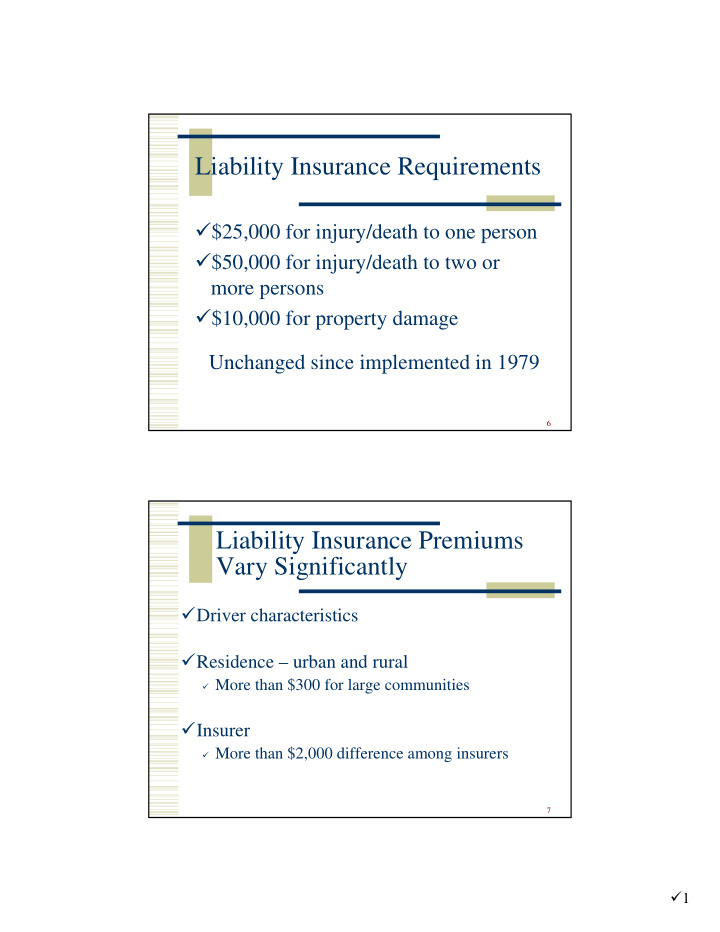



Liability Insurance Requirements � $25,000 for injury/death to one person � $50,000 for injury/death to two or more persons � $10,000 for property damage Unchanged since implemented in 1979 6 Liability Insurance Premiums Vary Significantly � Driver characteristics � Residence – urban and rural � More than $300 for large communities � Insurer � More than $2,000 difference among insurers 7 � 1
Uninsured Motor Vehicles Are A Problem More Than 11% of Accidents Involved at Least One Uninsured Vehicle 8 Estimated Non-Compliance Rates Insurance Industry Estimate 9% Non-Compliance (based on injury claims data) 9 � 2
Estimated Non-Compliance Rates Cont’d Department Data Indicates Increasing Non-Compliance � 15% of convictions are for violating the law. � 17% increase in convictions 10 Estimated Non-Compliance Rates Cont’d – Other States � 14% non-compliance nationwide � 6% to +20% non-compliance in other states 11 � 3
Conclusion Between 9 and 15 percent of registered vehicles do not have liability insurance 74,000 – 115,000 Vehicles 12 Three Types of Controls � Detective – Identifying non-compliance � Prevention – Deterring non-compliance � Corrective – Preventing repeated non- compliance 13 � 4
Detecting Non-Compliance CONCLUSION Montana has ineffective detection controls � Rely on law enforcement to detect non- compliance � (5% chance of being caught) � Insurance cards have limited value 14 Preventive Controls (Deterrents) CONCLUSION Penalties are ineffective deterrents � Fines may be less costly than insurance � Jail not a likely option 15 � 5
Corrective Controls CONCLUSION Registration and driver license suspensions are not effective at preventing continued non-compliance 16 Corrective Controls (cont’d) � Suspensions don’t affect some drivers � Suspensions may unfairly penalize some drivers � Driver license suspensions can’t always be imposed � Penalties for subsequent offenses may be less than for 1 st offense � Some drivers may keep license plates 17 � 6
Alternatives for Improving Detection � Sampling programs � Reporting systems � Verification systems 18 Sampling Programs � Probably less costly � Only detect non-compliance in sample � Detection risk may remain low � Requires all persons in sample to demonstrate compliance � Persons can still cancel insurance 19 � 7
Reporting Systems � Widely used by almost one-half the states � Requires insurers to regularly provide policy data � Data is quickly outdated � More costly than sampling systems 20 Verification Systems � Provides real-time verification of vehicle insurance status � Requires only data necessary to verify insurance status � New system 21 � 8
Improving Preventive Controls (Deterrence) � Increased fines � Increase administrative fees � Registration reinstatement � Driver license reinstatement � Increased penalties provides only marginal improvements � Detection risk remains low 22 Improving Corrective Controls (Preventing repeat offenses) � Expand use of SR22 insurance � Insurers required to notify state if SR22 policy is canceled. � SR22 liability insurance tied to an individual – not a vehicle 23 � 9
Effectiveness of Alternative Strategies Improved Detection Appears to be Most Effective Strategy 24 Impact on Insurance Rates � Impact on insurance rates unknown � No immediate impact – insurance based on long term claims history � Other factors impact insurance rates � Highway safety � Vehicle safety 25 � 10
Overall Conclusion � Montana Can Improve Compliance � Potential reduction in non-compliance and estimated cost benefits cannot be readily determined 26 Overall Conclusion (cont’d) Legislators must balance costs and public benefits of improved compliance with the law 27 � 11
Recommend
More recommend